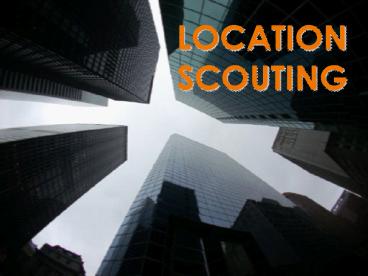LOCATION SCOUTING - PowerPoint PPT Presentation
1 / 14
Title:
LOCATION SCOUTING
Description:
The Location Scout can't decide the scene would be better on the beach. ... Note: The Location Scout does not view these facts as unimportant but ... – PowerPoint PPT presentation
Number of Views:1141
Avg rating:3.0/5.0
Title: LOCATION SCOUTING
1
LOCATION SCOUTING
2
Where To Begin
- Location Breakdown
- Research
- Consultations with Director, Production Designer,
and UPM - Scouting
- For creative needs
- For logistical needs
3
Creating a Location Breakdown
- List all locations
- List Scene s to be shot in each location
- List 1/8ths to be shot in each location
- List approximate duration of shoot for each
location (if schedule available) - Summarize Primary Fact
- Facts about the location indicated in the
slugline, in character dialogue, or character
interaction with the environment - Summarize Secondary Facts
- Descriptions in the scene text that do not
directly affect dialogue or character
interaction. - Summarize Potential Structural Issues
- Will wallpaper or installing of fixtures be
required, etc.?
4
Understanding Primary vs. Secondary Facts
- A Primary Fact is tied to location identity
(slugline), direct dialogue, or specific action
of the character - INT. HIGH RISE OFFICE - DAY The fact of the
office is non-negotiable. The Location Scout
cant decide the scene would be better on the
beach. - John, will you open the sliding glass door.
John cant then stand up and open a French door. - Cathie looks out the window. Clearly, the room
will have to have a window if Cathie must look
out of it.
5
Understanding Primary vs. Secondary Facts
- A Secondary Fact is any descriptor or feature
that can potentially be abandoned without
directly affecting the actors or the scene - Room layout that does not directly affect
character action. - Colors and textures.
- Really anything that a character doesnt interact
with or refer to. - Note The Location Scout does not view these
facts as unimportant but understands that some
aspects of practical locations must be flexible
or no film would ever be shot outside a studio or
backlot.
6
Conducting Research
- Before consulting the Director or Production
Designer, the Location Scout should make sure
he/she understand the design language of the
script. - E.G. period research, architectural research,
cultural research, professional research (what
does an accounting office look like?)
7
Consultation
- Always check your assumptions
- Does your understanding square with the
Directors and the Designers? - Are there things in the script they plan on
changing in production. - What are the logistical needs of the crew? Ask
the UPM.
8
Scouting Questions Part 1
- Does this location serve the creative needs of
the script? - Primary Facts present?
- Secondary Fact present or possible?
- Does this location serve the logistical needs of
the crew? - Bathrooms?
- Staging areas? Catering space?
- Parking?
- Power?
- Ease of access? Loading areas?
9
Scouting Questions Part 2
- Does this location avoid unnecessary headaches?
- Sound issues?
- Planes, trains, construction, busy highways,
schools, fire stations, etc. - Permits necessary?
- Film friendly neighbors?
- Safe?
- Heavy vehicle or pedestrian traffic?
10
Scouting Questions Part 3
- Basic info?
- Address? Directions?
- Compass/sun orientation?
- Adjacent properties/businesses?
- Who controls this location?
- Owners contact info?
- Renters contact info?
- Permitting authority info?
- Can we get it?
- Never show a director a location that youre not
95 sure you can get.
11
How to Shoot Location Photos
- Shoot lots of photos. Sort and select later.
- Shoot master shots of every room, establishing
shots of every exterior. - Shoot every direction.
- Cover all important features, especially primary
facts. - Cover all entrances/exits.
- Shoot panoramic views.
- Shoot multiple lighting situations.
- Shoot staging areas and parking where applicable.
12
Creating a Site Plan
- Parking for cast crew.
- Parking for trucks, genny.
- Loading areas.
- Holding areas.
- Catering Craft Service.
13
Why Create a Site Plan?
- Check to make sure location meets logistical
needs - Guides crew loading in on day of shoot (where
does this grip truck go, anyway?) - Shows permitting authority that a professional
crew knows what theyre doing
14
(No Transcript)































